Performance Management: Environmental Cost and Decision Making
VerifiedAdded on 2023/01/04
|16
|4834
|269
Report
AI Summary
This report delves into performance management, emphasizing environmental cost analysis and its impact on businesses. It explores environmental cost management accounting techniques, including input/outflow analysis, flow cost accounting, activity-based costing, and lifecycle costing. The report examines cost-benefit analysis, the significance of environmental cost management, and methods for identifying and recording environmental costs. Furthermore, it highlights the importance of decision-making processes, the role of management accounting in providing accurate information, and the relevance of planning tools, budgetary control, and key performance indicators (KPIs) in improving financial performance and achieving business financial sustainability. The report concludes by underscoring the interconnectedness of environmental responsibility and financial success.
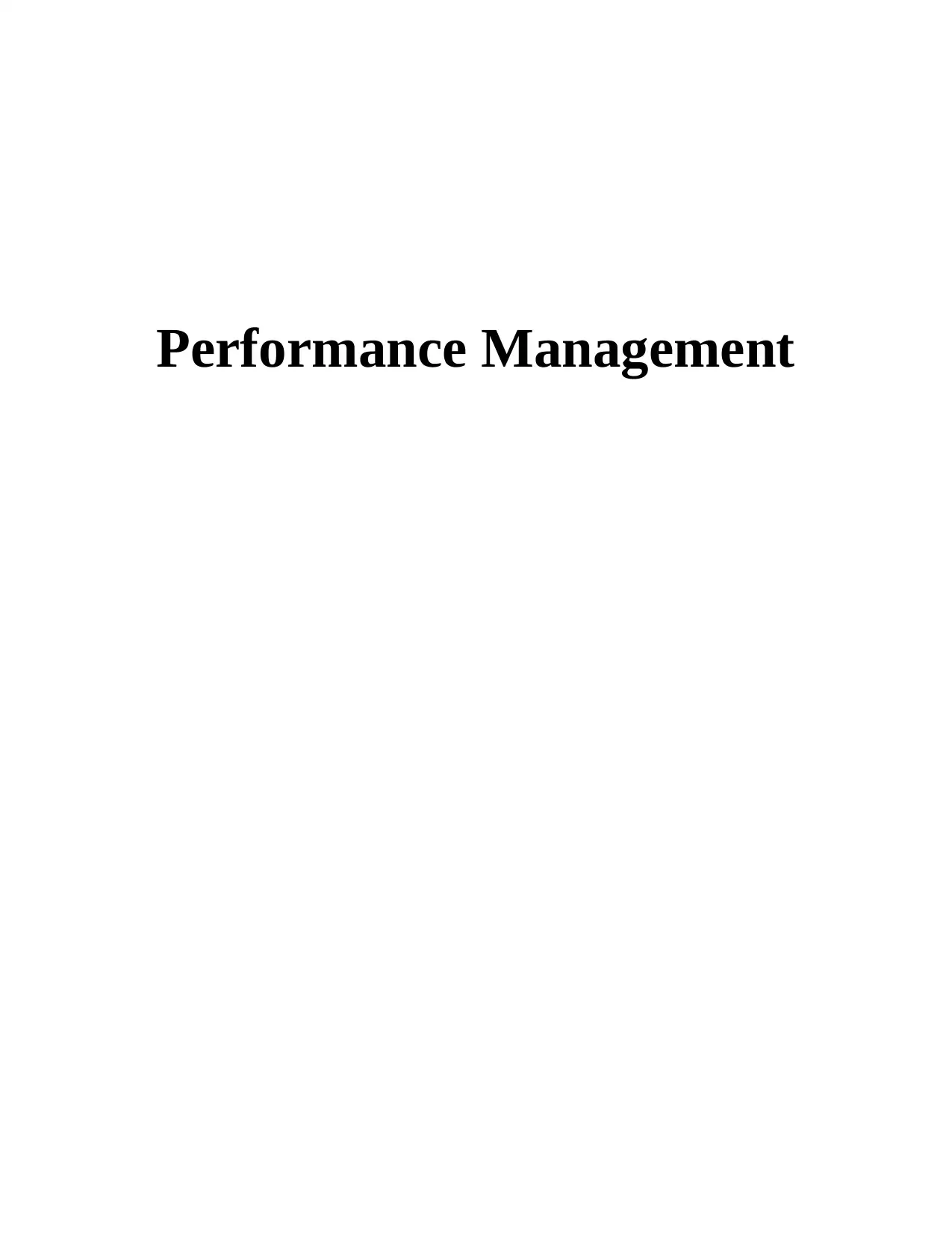
Performance Management
Paraphrase This Document
Need a fresh take? Get an instant paraphrase of this document with our AI Paraphraser
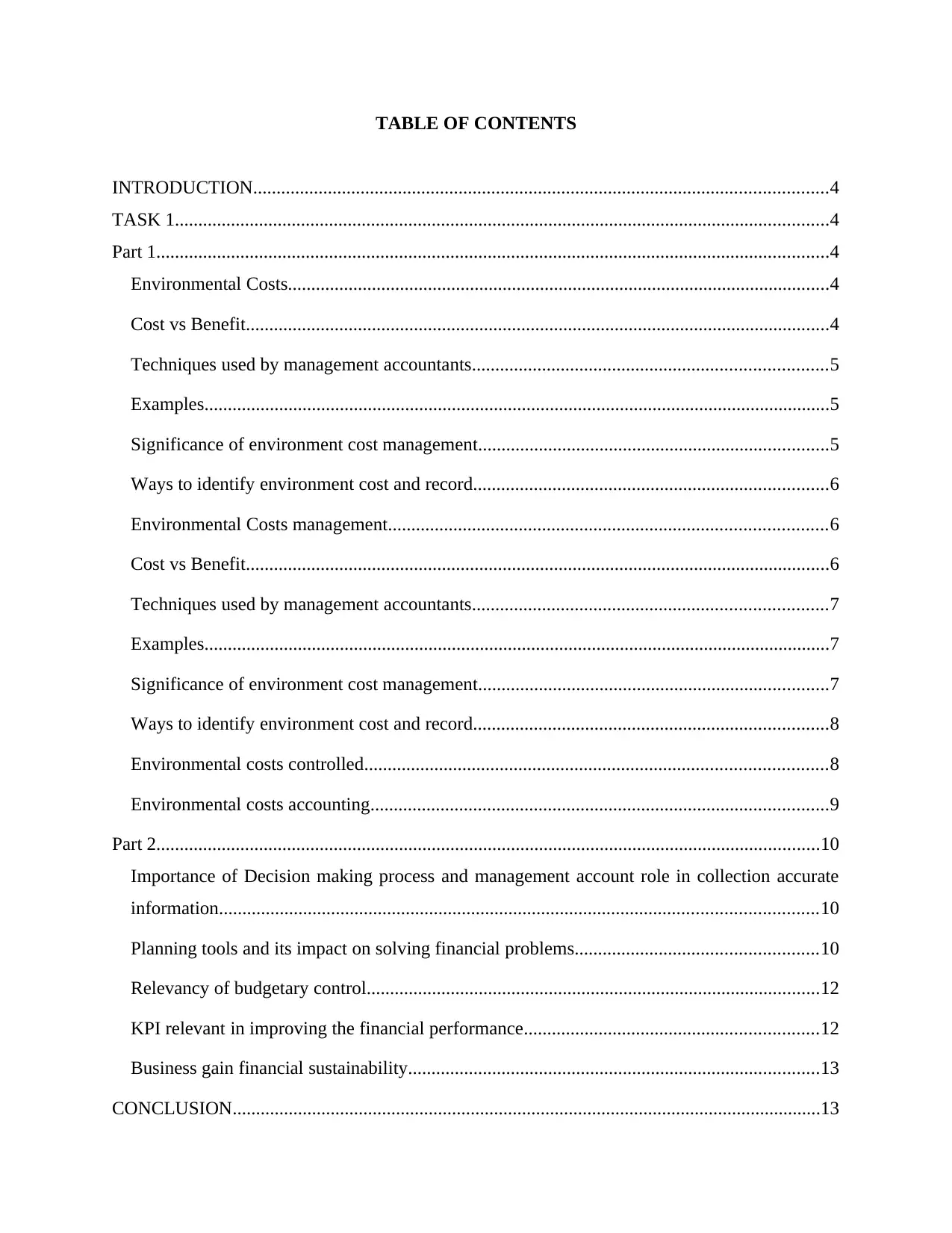
TABLE OF CONTENTS
INTRODUCTION...........................................................................................................................4
TASK 1............................................................................................................................................4
Part 1................................................................................................................................................4
Environmental Costs....................................................................................................................4
Cost vs Benefit.............................................................................................................................4
Techniques used by management accountants............................................................................5
Examples......................................................................................................................................5
Significance of environment cost management...........................................................................5
Ways to identify environment cost and record............................................................................6
Environmental Costs management..............................................................................................6
Cost vs Benefit.............................................................................................................................6
Techniques used by management accountants............................................................................7
Examples......................................................................................................................................7
Significance of environment cost management...........................................................................7
Ways to identify environment cost and record............................................................................8
Environmental costs controlled...................................................................................................8
Environmental costs accounting..................................................................................................9
Part 2..............................................................................................................................................10
Importance of Decision making process and management account role in collection accurate
information................................................................................................................................10
Planning tools and its impact on solving financial problems....................................................10
Relevancy of budgetary control.................................................................................................12
KPI relevant in improving the financial performance...............................................................12
Business gain financial sustainability........................................................................................13
CONCLUSION..............................................................................................................................13
INTRODUCTION...........................................................................................................................4
TASK 1............................................................................................................................................4
Part 1................................................................................................................................................4
Environmental Costs....................................................................................................................4
Cost vs Benefit.............................................................................................................................4
Techniques used by management accountants............................................................................5
Examples......................................................................................................................................5
Significance of environment cost management...........................................................................5
Ways to identify environment cost and record............................................................................6
Environmental Costs management..............................................................................................6
Cost vs Benefit.............................................................................................................................6
Techniques used by management accountants............................................................................7
Examples......................................................................................................................................7
Significance of environment cost management...........................................................................7
Ways to identify environment cost and record............................................................................8
Environmental costs controlled...................................................................................................8
Environmental costs accounting..................................................................................................9
Part 2..............................................................................................................................................10
Importance of Decision making process and management account role in collection accurate
information................................................................................................................................10
Planning tools and its impact on solving financial problems....................................................10
Relevancy of budgetary control.................................................................................................12
KPI relevant in improving the financial performance...............................................................12
Business gain financial sustainability........................................................................................13
CONCLUSION..............................................................................................................................13

REFERENCES..............................................................................................................................14
⊘ This is a preview!⊘
Do you want full access?
Subscribe today to unlock all pages.

Trusted by 1+ million students worldwide
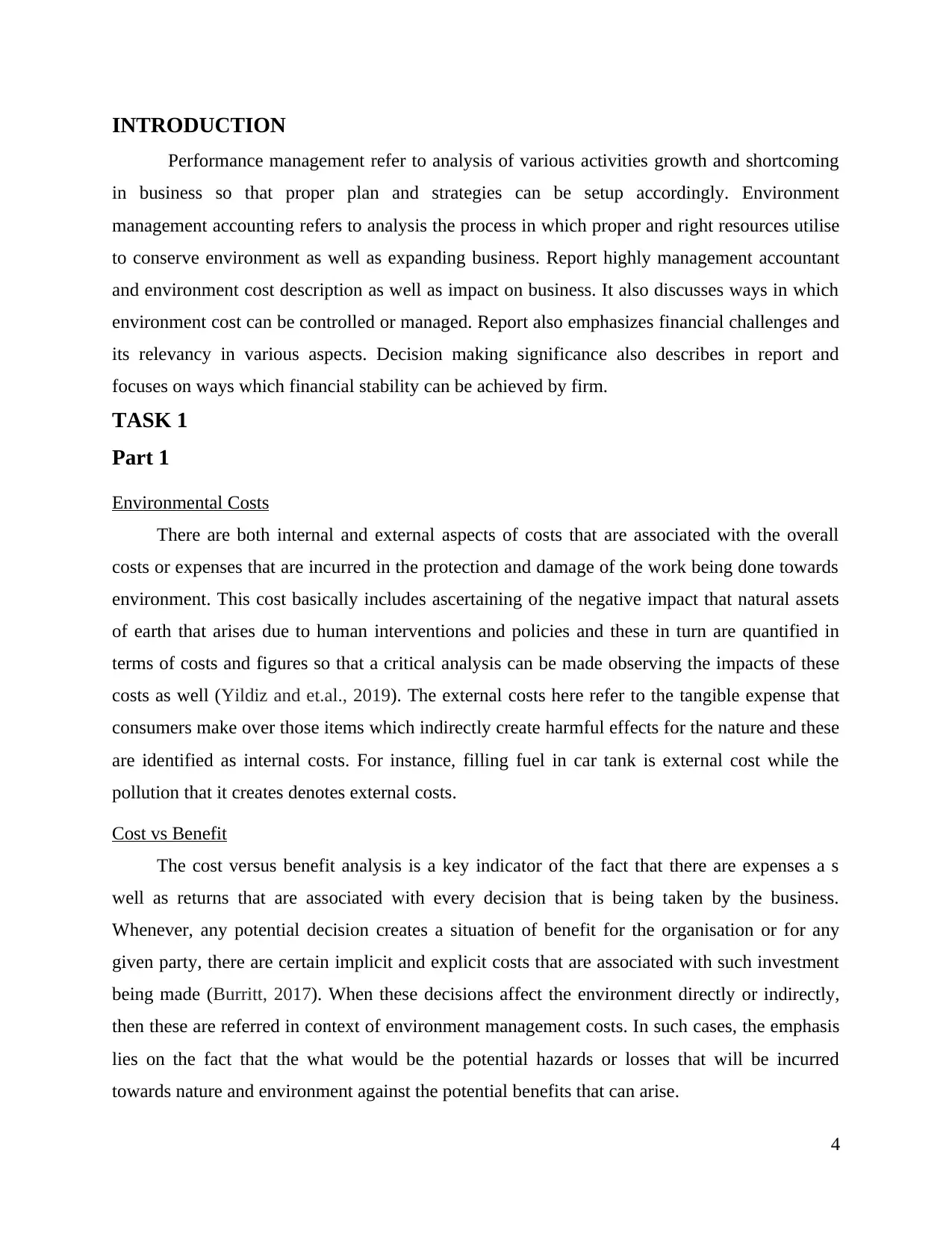
INTRODUCTION
Performance management refer to analysis of various activities growth and shortcoming
in business so that proper plan and strategies can be setup accordingly. Environment
management accounting refers to analysis the process in which proper and right resources utilise
to conserve environment as well as expanding business. Report highly management accountant
and environment cost description as well as impact on business. It also discusses ways in which
environment cost can be controlled or managed. Report also emphasizes financial challenges and
its relevancy in various aspects. Decision making significance also describes in report and
focuses on ways which financial stability can be achieved by firm.
TASK 1
Part 1
Environmental Costs
There are both internal and external aspects of costs that are associated with the overall
costs or expenses that are incurred in the protection and damage of the work being done towards
environment. This cost basically includes ascertaining of the negative impact that natural assets
of earth that arises due to human interventions and policies and these in turn are quantified in
terms of costs and figures so that a critical analysis can be made observing the impacts of these
costs as well (Yildiz and et.al., 2019). The external costs here refer to the tangible expense that
consumers make over those items which indirectly create harmful effects for the nature and these
are identified as internal costs. For instance, filling fuel in car tank is external cost while the
pollution that it creates denotes external costs.
Cost vs Benefit
The cost versus benefit analysis is a key indicator of the fact that there are expenses a s
well as returns that are associated with every decision that is being taken by the business.
Whenever, any potential decision creates a situation of benefit for the organisation or for any
given party, there are certain implicit and explicit costs that are associated with such investment
being made (Burritt, 2017). When these decisions affect the environment directly or indirectly,
then these are referred in context of environment management costs. In such cases, the emphasis
lies on the fact that the what would be the potential hazards or losses that will be incurred
towards nature and environment against the potential benefits that can arise.
4
Performance management refer to analysis of various activities growth and shortcoming
in business so that proper plan and strategies can be setup accordingly. Environment
management accounting refers to analysis the process in which proper and right resources utilise
to conserve environment as well as expanding business. Report highly management accountant
and environment cost description as well as impact on business. It also discusses ways in which
environment cost can be controlled or managed. Report also emphasizes financial challenges and
its relevancy in various aspects. Decision making significance also describes in report and
focuses on ways which financial stability can be achieved by firm.
TASK 1
Part 1
Environmental Costs
There are both internal and external aspects of costs that are associated with the overall
costs or expenses that are incurred in the protection and damage of the work being done towards
environment. This cost basically includes ascertaining of the negative impact that natural assets
of earth that arises due to human interventions and policies and these in turn are quantified in
terms of costs and figures so that a critical analysis can be made observing the impacts of these
costs as well (Yildiz and et.al., 2019). The external costs here refer to the tangible expense that
consumers make over those items which indirectly create harmful effects for the nature and these
are identified as internal costs. For instance, filling fuel in car tank is external cost while the
pollution that it creates denotes external costs.
Cost vs Benefit
The cost versus benefit analysis is a key indicator of the fact that there are expenses a s
well as returns that are associated with every decision that is being taken by the business.
Whenever, any potential decision creates a situation of benefit for the organisation or for any
given party, there are certain implicit and explicit costs that are associated with such investment
being made (Burritt, 2017). When these decisions affect the environment directly or indirectly,
then these are referred in context of environment management costs. In such cases, the emphasis
lies on the fact that the what would be the potential hazards or losses that will be incurred
towards nature and environment against the potential benefits that can arise.
4
Paraphrase This Document
Need a fresh take? Get an instant paraphrase of this document with our AI Paraphraser
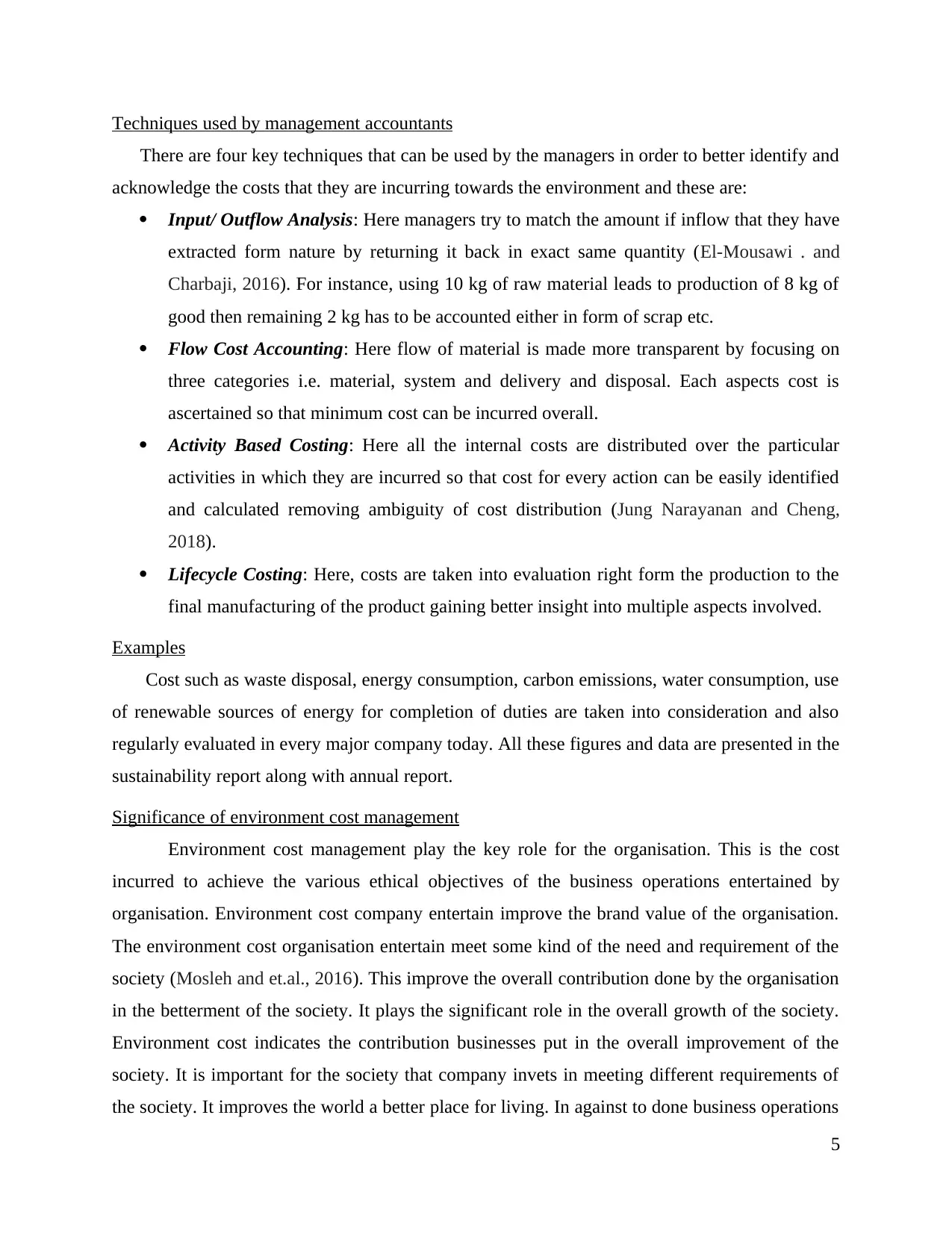
Techniques used by management accountants
There are four key techniques that can be used by the managers in order to better identify and
acknowledge the costs that they are incurring towards the environment and these are:
Input/ Outflow Analysis: Here managers try to match the amount if inflow that they have
extracted form nature by returning it back in exact same quantity (El-Mousawi . and
Charbaji, 2016). For instance, using 10 kg of raw material leads to production of 8 kg of
good then remaining 2 kg has to be accounted either in form of scrap etc.
Flow Cost Accounting: Here flow of material is made more transparent by focusing on
three categories i.e. material, system and delivery and disposal. Each aspects cost is
ascertained so that minimum cost can be incurred overall.
Activity Based Costing: Here all the internal costs are distributed over the particular
activities in which they are incurred so that cost for every action can be easily identified
and calculated removing ambiguity of cost distribution (Jung Narayanan and Cheng,
2018).
Lifecycle Costing: Here, costs are taken into evaluation right form the production to the
final manufacturing of the product gaining better insight into multiple aspects involved.
Examples
Cost such as waste disposal, energy consumption, carbon emissions, water consumption, use
of renewable sources of energy for completion of duties are taken into consideration and also
regularly evaluated in every major company today. All these figures and data are presented in the
sustainability report along with annual report.
Significance of environment cost management
Environment cost management play the key role for the organisation. This is the cost
incurred to achieve the various ethical objectives of the business operations entertained by
organisation. Environment cost company entertain improve the brand value of the organisation.
The environment cost organisation entertain meet some kind of the need and requirement of the
society (Mosleh and et.al., 2016). This improve the overall contribution done by the organisation
in the betterment of the society. It plays the significant role in the overall growth of the society.
Environment cost indicates the contribution businesses put in the overall improvement of the
society. It is important for the society that company invets in meeting different requirements of
the society. It improves the world a better place for living. In against to done business operations
5
There are four key techniques that can be used by the managers in order to better identify and
acknowledge the costs that they are incurring towards the environment and these are:
Input/ Outflow Analysis: Here managers try to match the amount if inflow that they have
extracted form nature by returning it back in exact same quantity (El-Mousawi . and
Charbaji, 2016). For instance, using 10 kg of raw material leads to production of 8 kg of
good then remaining 2 kg has to be accounted either in form of scrap etc.
Flow Cost Accounting: Here flow of material is made more transparent by focusing on
three categories i.e. material, system and delivery and disposal. Each aspects cost is
ascertained so that minimum cost can be incurred overall.
Activity Based Costing: Here all the internal costs are distributed over the particular
activities in which they are incurred so that cost for every action can be easily identified
and calculated removing ambiguity of cost distribution (Jung Narayanan and Cheng,
2018).
Lifecycle Costing: Here, costs are taken into evaluation right form the production to the
final manufacturing of the product gaining better insight into multiple aspects involved.
Examples
Cost such as waste disposal, energy consumption, carbon emissions, water consumption, use
of renewable sources of energy for completion of duties are taken into consideration and also
regularly evaluated in every major company today. All these figures and data are presented in the
sustainability report along with annual report.
Significance of environment cost management
Environment cost management play the key role for the organisation. This is the cost
incurred to achieve the various ethical objectives of the business operations entertained by
organisation. Environment cost company entertain improve the brand value of the organisation.
The environment cost organisation entertain meet some kind of the need and requirement of the
society (Mosleh and et.al., 2016). This improve the overall contribution done by the organisation
in the betterment of the society. It plays the significant role in the overall growth of the society.
Environment cost indicates the contribution businesses put in the overall improvement of the
society. It is important for the society that company invets in meeting different requirements of
the society. It improves the world a better place for living. In against to done business operations
5
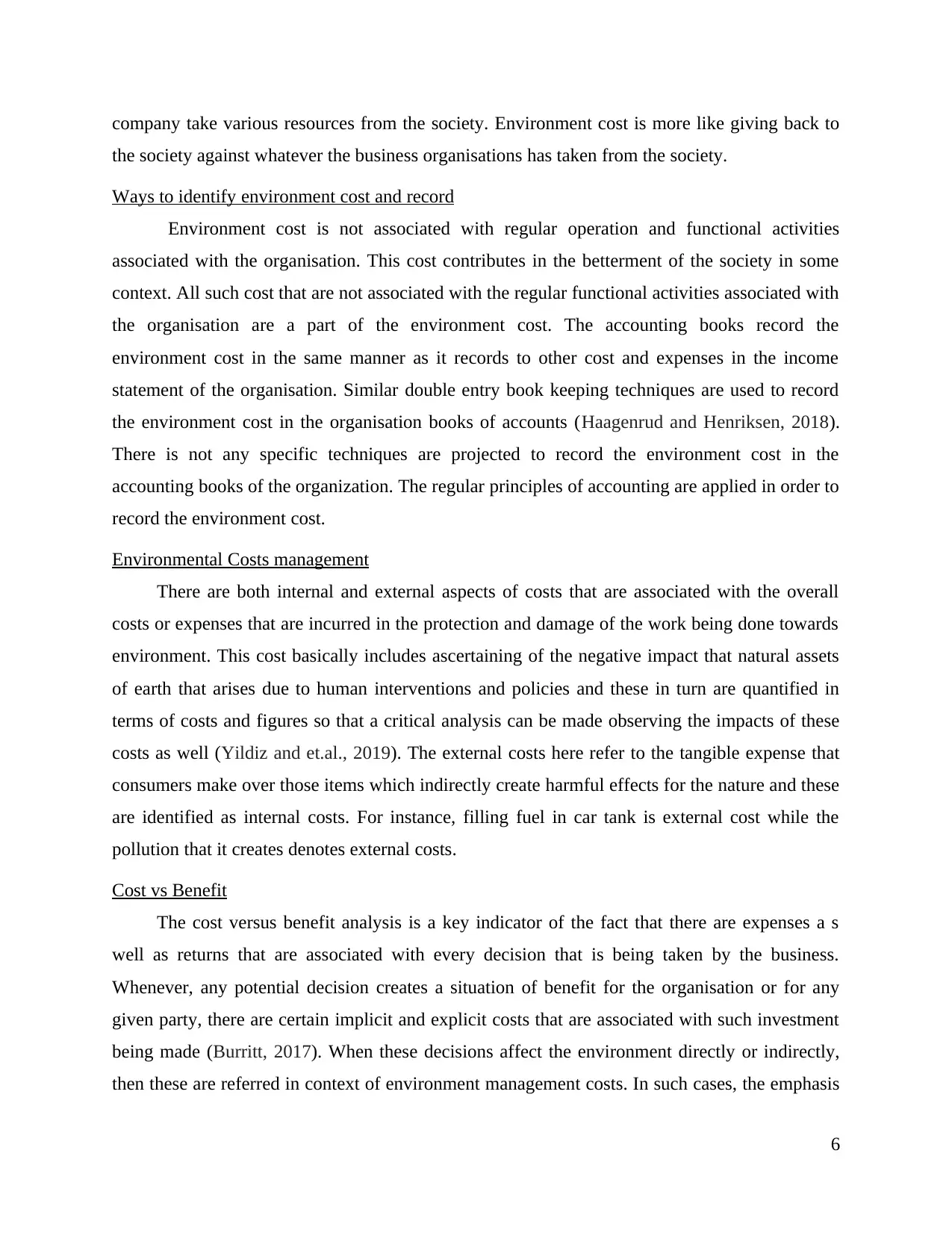
company take various resources from the society. Environment cost is more like giving back to
the society against whatever the business organisations has taken from the society.
Ways to identify environment cost and record
Environment cost is not associated with regular operation and functional activities
associated with the organisation. This cost contributes in the betterment of the society in some
context. All such cost that are not associated with the regular functional activities associated with
the organisation are a part of the environment cost. The accounting books record the
environment cost in the same manner as it records to other cost and expenses in the income
statement of the organisation. Similar double entry book keeping techniques are used to record
the environment cost in the organisation books of accounts (Haagenrud and Henriksen, 2018).
There is not any specific techniques are projected to record the environment cost in the
accounting books of the organization. The regular principles of accounting are applied in order to
record the environment cost.
Environmental Costs management
There are both internal and external aspects of costs that are associated with the overall
costs or expenses that are incurred in the protection and damage of the work being done towards
environment. This cost basically includes ascertaining of the negative impact that natural assets
of earth that arises due to human interventions and policies and these in turn are quantified in
terms of costs and figures so that a critical analysis can be made observing the impacts of these
costs as well (Yildiz and et.al., 2019). The external costs here refer to the tangible expense that
consumers make over those items which indirectly create harmful effects for the nature and these
are identified as internal costs. For instance, filling fuel in car tank is external cost while the
pollution that it creates denotes external costs.
Cost vs Benefit
The cost versus benefit analysis is a key indicator of the fact that there are expenses a s
well as returns that are associated with every decision that is being taken by the business.
Whenever, any potential decision creates a situation of benefit for the organisation or for any
given party, there are certain implicit and explicit costs that are associated with such investment
being made (Burritt, 2017). When these decisions affect the environment directly or indirectly,
then these are referred in context of environment management costs. In such cases, the emphasis
6
the society against whatever the business organisations has taken from the society.
Ways to identify environment cost and record
Environment cost is not associated with regular operation and functional activities
associated with the organisation. This cost contributes in the betterment of the society in some
context. All such cost that are not associated with the regular functional activities associated with
the organisation are a part of the environment cost. The accounting books record the
environment cost in the same manner as it records to other cost and expenses in the income
statement of the organisation. Similar double entry book keeping techniques are used to record
the environment cost in the organisation books of accounts (Haagenrud and Henriksen, 2018).
There is not any specific techniques are projected to record the environment cost in the
accounting books of the organization. The regular principles of accounting are applied in order to
record the environment cost.
Environmental Costs management
There are both internal and external aspects of costs that are associated with the overall
costs or expenses that are incurred in the protection and damage of the work being done towards
environment. This cost basically includes ascertaining of the negative impact that natural assets
of earth that arises due to human interventions and policies and these in turn are quantified in
terms of costs and figures so that a critical analysis can be made observing the impacts of these
costs as well (Yildiz and et.al., 2019). The external costs here refer to the tangible expense that
consumers make over those items which indirectly create harmful effects for the nature and these
are identified as internal costs. For instance, filling fuel in car tank is external cost while the
pollution that it creates denotes external costs.
Cost vs Benefit
The cost versus benefit analysis is a key indicator of the fact that there are expenses a s
well as returns that are associated with every decision that is being taken by the business.
Whenever, any potential decision creates a situation of benefit for the organisation or for any
given party, there are certain implicit and explicit costs that are associated with such investment
being made (Burritt, 2017). When these decisions affect the environment directly or indirectly,
then these are referred in context of environment management costs. In such cases, the emphasis
6
⊘ This is a preview!⊘
Do you want full access?
Subscribe today to unlock all pages.

Trusted by 1+ million students worldwide
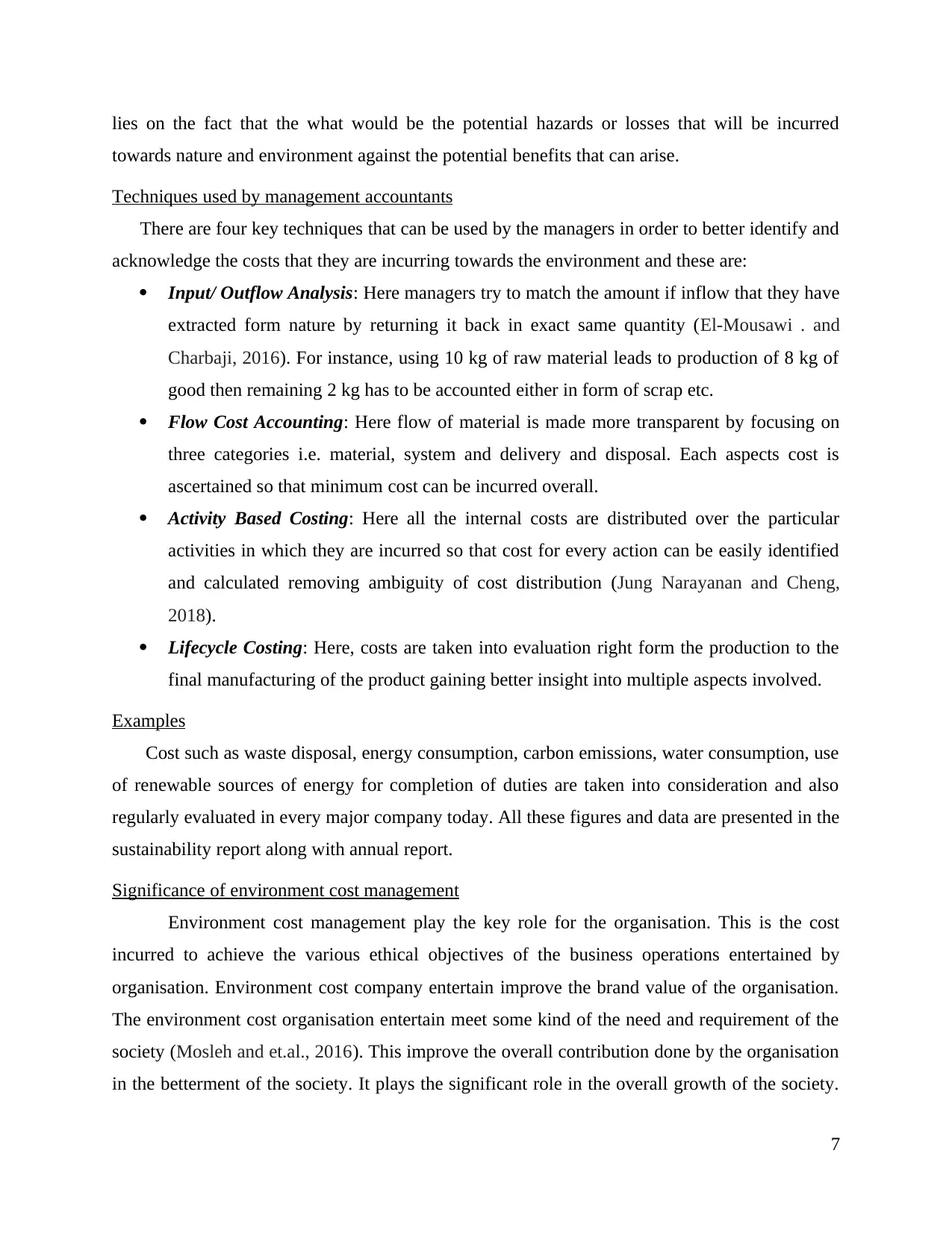
lies on the fact that the what would be the potential hazards or losses that will be incurred
towards nature and environment against the potential benefits that can arise.
Techniques used by management accountants
There are four key techniques that can be used by the managers in order to better identify and
acknowledge the costs that they are incurring towards the environment and these are:
Input/ Outflow Analysis: Here managers try to match the amount if inflow that they have
extracted form nature by returning it back in exact same quantity (El-Mousawi . and
Charbaji, 2016). For instance, using 10 kg of raw material leads to production of 8 kg of
good then remaining 2 kg has to be accounted either in form of scrap etc.
Flow Cost Accounting: Here flow of material is made more transparent by focusing on
three categories i.e. material, system and delivery and disposal. Each aspects cost is
ascertained so that minimum cost can be incurred overall.
Activity Based Costing: Here all the internal costs are distributed over the particular
activities in which they are incurred so that cost for every action can be easily identified
and calculated removing ambiguity of cost distribution (Jung Narayanan and Cheng,
2018).
Lifecycle Costing: Here, costs are taken into evaluation right form the production to the
final manufacturing of the product gaining better insight into multiple aspects involved.
Examples
Cost such as waste disposal, energy consumption, carbon emissions, water consumption, use
of renewable sources of energy for completion of duties are taken into consideration and also
regularly evaluated in every major company today. All these figures and data are presented in the
sustainability report along with annual report.
Significance of environment cost management
Environment cost management play the key role for the organisation. This is the cost
incurred to achieve the various ethical objectives of the business operations entertained by
organisation. Environment cost company entertain improve the brand value of the organisation.
The environment cost organisation entertain meet some kind of the need and requirement of the
society (Mosleh and et.al., 2016). This improve the overall contribution done by the organisation
in the betterment of the society. It plays the significant role in the overall growth of the society.
7
towards nature and environment against the potential benefits that can arise.
Techniques used by management accountants
There are four key techniques that can be used by the managers in order to better identify and
acknowledge the costs that they are incurring towards the environment and these are:
Input/ Outflow Analysis: Here managers try to match the amount if inflow that they have
extracted form nature by returning it back in exact same quantity (El-Mousawi . and
Charbaji, 2016). For instance, using 10 kg of raw material leads to production of 8 kg of
good then remaining 2 kg has to be accounted either in form of scrap etc.
Flow Cost Accounting: Here flow of material is made more transparent by focusing on
three categories i.e. material, system and delivery and disposal. Each aspects cost is
ascertained so that minimum cost can be incurred overall.
Activity Based Costing: Here all the internal costs are distributed over the particular
activities in which they are incurred so that cost for every action can be easily identified
and calculated removing ambiguity of cost distribution (Jung Narayanan and Cheng,
2018).
Lifecycle Costing: Here, costs are taken into evaluation right form the production to the
final manufacturing of the product gaining better insight into multiple aspects involved.
Examples
Cost such as waste disposal, energy consumption, carbon emissions, water consumption, use
of renewable sources of energy for completion of duties are taken into consideration and also
regularly evaluated in every major company today. All these figures and data are presented in the
sustainability report along with annual report.
Significance of environment cost management
Environment cost management play the key role for the organisation. This is the cost
incurred to achieve the various ethical objectives of the business operations entertained by
organisation. Environment cost company entertain improve the brand value of the organisation.
The environment cost organisation entertain meet some kind of the need and requirement of the
society (Mosleh and et.al., 2016). This improve the overall contribution done by the organisation
in the betterment of the society. It plays the significant role in the overall growth of the society.
7
Paraphrase This Document
Need a fresh take? Get an instant paraphrase of this document with our AI Paraphraser
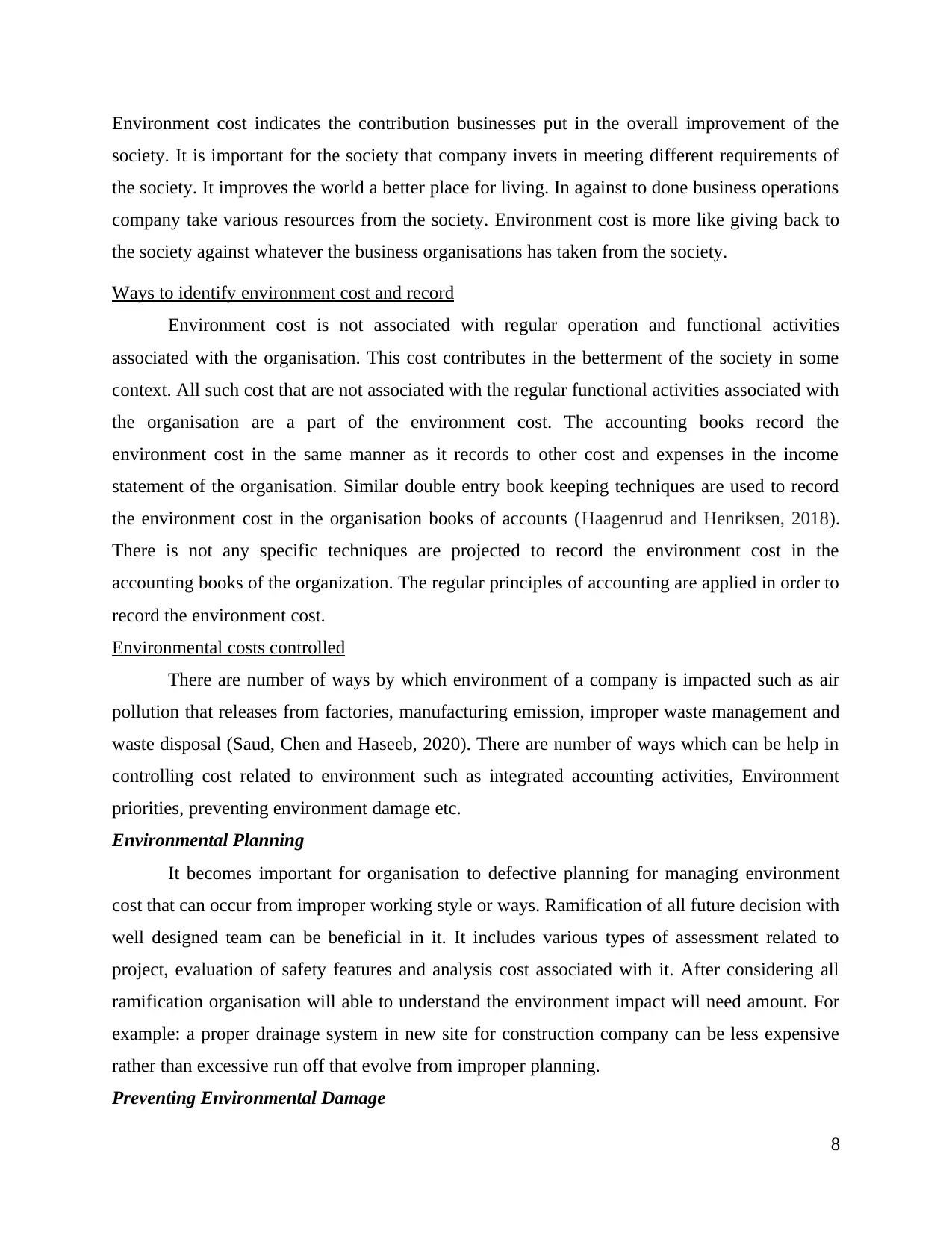
Environment cost indicates the contribution businesses put in the overall improvement of the
society. It is important for the society that company invets in meeting different requirements of
the society. It improves the world a better place for living. In against to done business operations
company take various resources from the society. Environment cost is more like giving back to
the society against whatever the business organisations has taken from the society.
Ways to identify environment cost and record
Environment cost is not associated with regular operation and functional activities
associated with the organisation. This cost contributes in the betterment of the society in some
context. All such cost that are not associated with the regular functional activities associated with
the organisation are a part of the environment cost. The accounting books record the
environment cost in the same manner as it records to other cost and expenses in the income
statement of the organisation. Similar double entry book keeping techniques are used to record
the environment cost in the organisation books of accounts (Haagenrud and Henriksen, 2018).
There is not any specific techniques are projected to record the environment cost in the
accounting books of the organization. The regular principles of accounting are applied in order to
record the environment cost.
Environmental costs controlled
There are number of ways by which environment of a company is impacted such as air
pollution that releases from factories, manufacturing emission, improper waste management and
waste disposal (Saud, Chen and Haseeb, 2020). There are number of ways which can be help in
controlling cost related to environment such as integrated accounting activities, Environment
priorities, preventing environment damage etc.
Environmental Planning
It becomes important for organisation to defective planning for managing environment
cost that can occur from improper working style or ways. Ramification of all future decision with
well designed team can be beneficial in it. It includes various types of assessment related to
project, evaluation of safety features and analysis cost associated with it. After considering all
ramification organisation will able to understand the environment impact will need amount. For
example: a proper drainage system in new site for construction company can be less expensive
rather than excessive run off that evolve from improper planning.
Preventing Environmental Damage
8
society. It is important for the society that company invets in meeting different requirements of
the society. It improves the world a better place for living. In against to done business operations
company take various resources from the society. Environment cost is more like giving back to
the society against whatever the business organisations has taken from the society.
Ways to identify environment cost and record
Environment cost is not associated with regular operation and functional activities
associated with the organisation. This cost contributes in the betterment of the society in some
context. All such cost that are not associated with the regular functional activities associated with
the organisation are a part of the environment cost. The accounting books record the
environment cost in the same manner as it records to other cost and expenses in the income
statement of the organisation. Similar double entry book keeping techniques are used to record
the environment cost in the organisation books of accounts (Haagenrud and Henriksen, 2018).
There is not any specific techniques are projected to record the environment cost in the
accounting books of the organization. The regular principles of accounting are applied in order to
record the environment cost.
Environmental costs controlled
There are number of ways by which environment of a company is impacted such as air
pollution that releases from factories, manufacturing emission, improper waste management and
waste disposal (Saud, Chen and Haseeb, 2020). There are number of ways which can be help in
controlling cost related to environment such as integrated accounting activities, Environment
priorities, preventing environment damage etc.
Environmental Planning
It becomes important for organisation to defective planning for managing environment
cost that can occur from improper working style or ways. Ramification of all future decision with
well designed team can be beneficial in it. It includes various types of assessment related to
project, evaluation of safety features and analysis cost associated with it. After considering all
ramification organisation will able to understand the environment impact will need amount. For
example: a proper drainage system in new site for construction company can be less expensive
rather than excessive run off that evolve from improper planning.
Preventing Environmental Damage
8
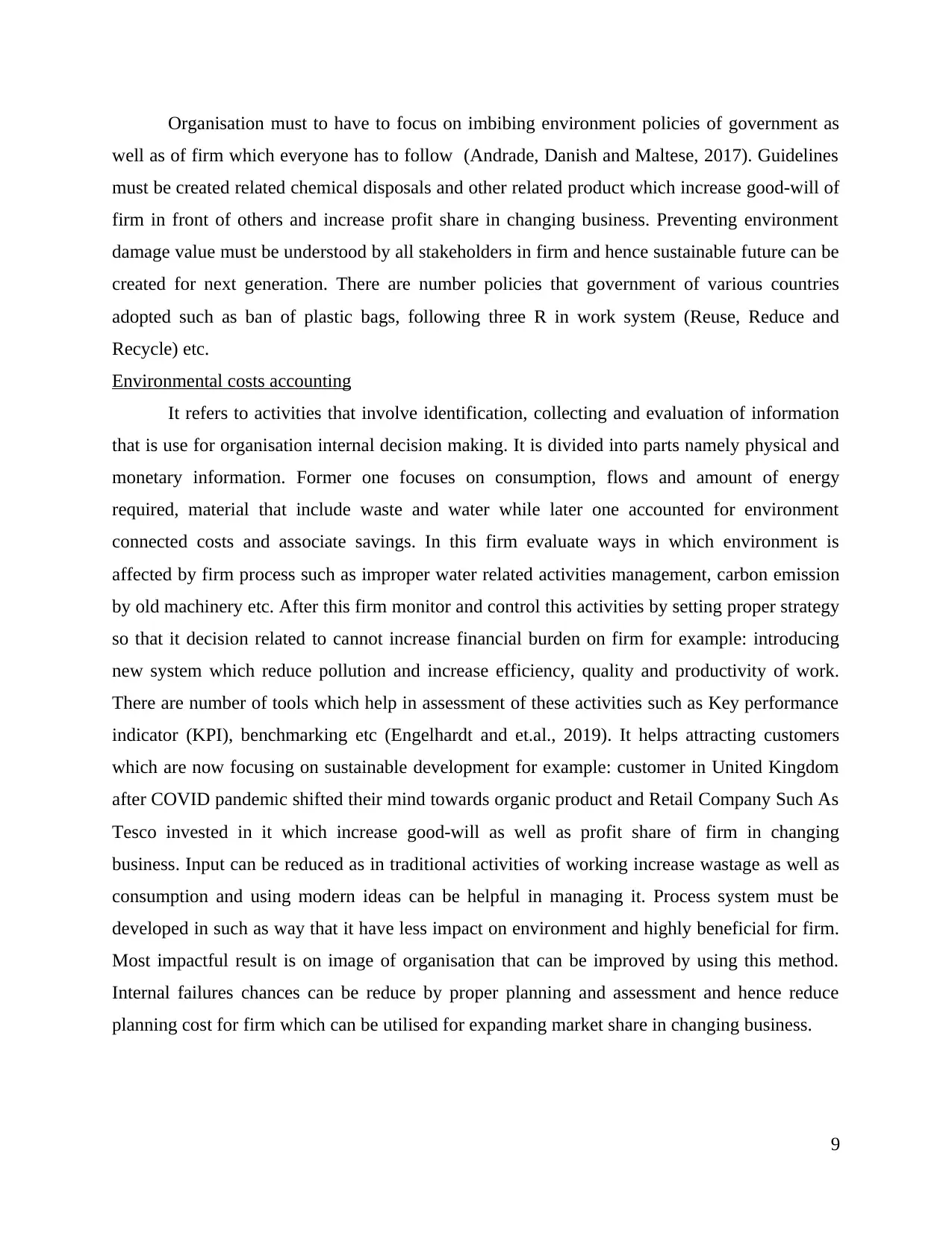
Organisation must to have to focus on imbibing environment policies of government as
well as of firm which everyone has to follow (Andrade, Danish and Maltese, 2017). Guidelines
must be created related chemical disposals and other related product which increase good-will of
firm in front of others and increase profit share in changing business. Preventing environment
damage value must be understood by all stakeholders in firm and hence sustainable future can be
created for next generation. There are number policies that government of various countries
adopted such as ban of plastic bags, following three R in work system (Reuse, Reduce and
Recycle) etc.
Environmental costs accounting
It refers to activities that involve identification, collecting and evaluation of information
that is use for organisation internal decision making. It is divided into parts namely physical and
monetary information. Former one focuses on consumption, flows and amount of energy
required, material that include waste and water while later one accounted for environment
connected costs and associate savings. In this firm evaluate ways in which environment is
affected by firm process such as improper water related activities management, carbon emission
by old machinery etc. After this firm monitor and control this activities by setting proper strategy
so that it decision related to cannot increase financial burden on firm for example: introducing
new system which reduce pollution and increase efficiency, quality and productivity of work.
There are number of tools which help in assessment of these activities such as Key performance
indicator (KPI), benchmarking etc (Engelhardt and et.al., 2019). It helps attracting customers
which are now focusing on sustainable development for example: customer in United Kingdom
after COVID pandemic shifted their mind towards organic product and Retail Company Such As
Tesco invested in it which increase good-will as well as profit share of firm in changing
business. Input can be reduced as in traditional activities of working increase wastage as well as
consumption and using modern ideas can be helpful in managing it. Process system must be
developed in such as way that it have less impact on environment and highly beneficial for firm.
Most impactful result is on image of organisation that can be improved by using this method.
Internal failures chances can be reduce by proper planning and assessment and hence reduce
planning cost for firm which can be utilised for expanding market share in changing business.
9
well as of firm which everyone has to follow (Andrade, Danish and Maltese, 2017). Guidelines
must be created related chemical disposals and other related product which increase good-will of
firm in front of others and increase profit share in changing business. Preventing environment
damage value must be understood by all stakeholders in firm and hence sustainable future can be
created for next generation. There are number policies that government of various countries
adopted such as ban of plastic bags, following three R in work system (Reuse, Reduce and
Recycle) etc.
Environmental costs accounting
It refers to activities that involve identification, collecting and evaluation of information
that is use for organisation internal decision making. It is divided into parts namely physical and
monetary information. Former one focuses on consumption, flows and amount of energy
required, material that include waste and water while later one accounted for environment
connected costs and associate savings. In this firm evaluate ways in which environment is
affected by firm process such as improper water related activities management, carbon emission
by old machinery etc. After this firm monitor and control this activities by setting proper strategy
so that it decision related to cannot increase financial burden on firm for example: introducing
new system which reduce pollution and increase efficiency, quality and productivity of work.
There are number of tools which help in assessment of these activities such as Key performance
indicator (KPI), benchmarking etc (Engelhardt and et.al., 2019). It helps attracting customers
which are now focusing on sustainable development for example: customer in United Kingdom
after COVID pandemic shifted their mind towards organic product and Retail Company Such As
Tesco invested in it which increase good-will as well as profit share of firm in changing
business. Input can be reduced as in traditional activities of working increase wastage as well as
consumption and using modern ideas can be helpful in managing it. Process system must be
developed in such as way that it have less impact on environment and highly beneficial for firm.
Most impactful result is on image of organisation that can be improved by using this method.
Internal failures chances can be reduce by proper planning and assessment and hence reduce
planning cost for firm which can be utilised for expanding market share in changing business.
9
⊘ This is a preview!⊘
Do you want full access?
Subscribe today to unlock all pages.

Trusted by 1+ million students worldwide
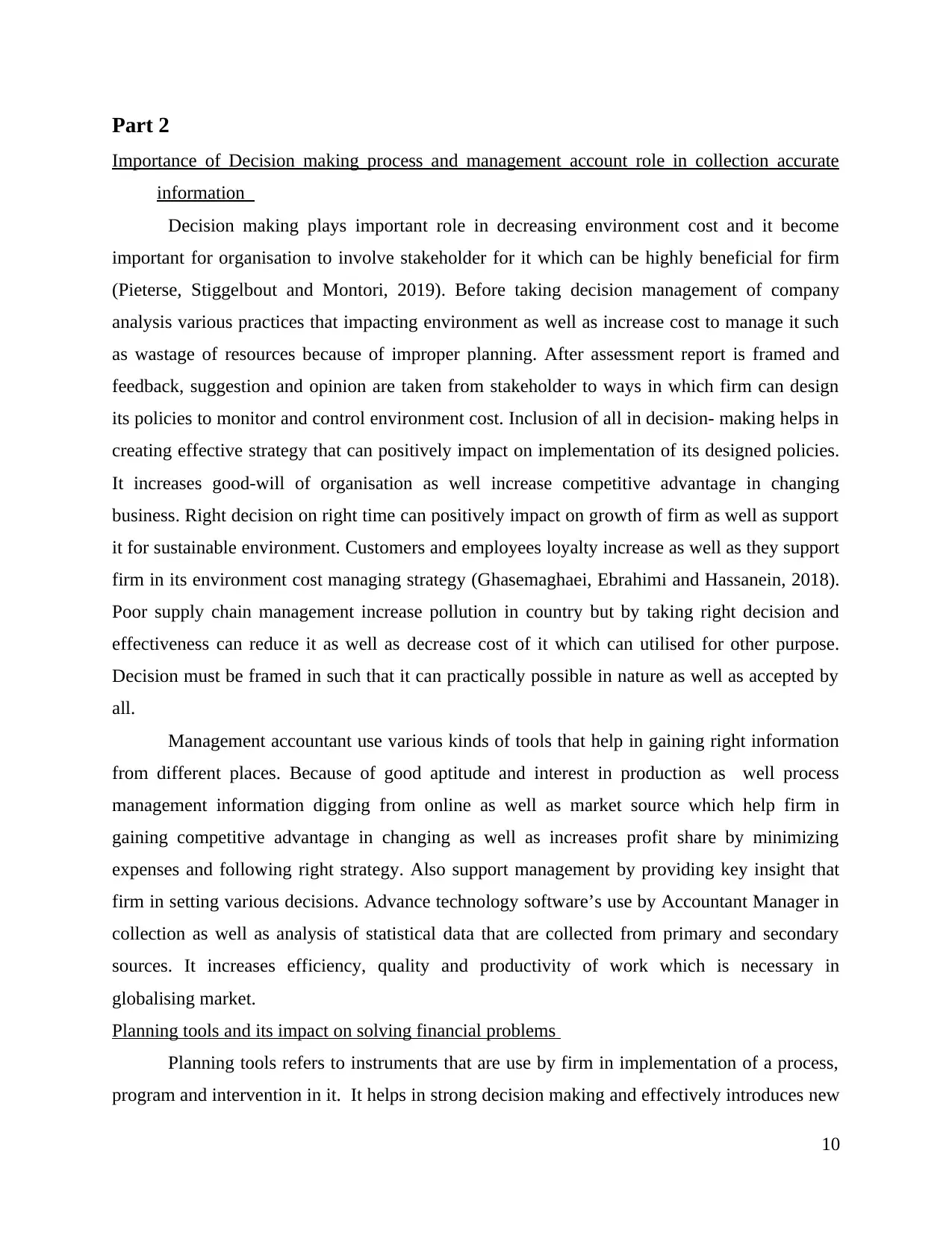
Part 2
Importance of Decision making process and management account role in collection accurate
information
Decision making plays important role in decreasing environment cost and it become
important for organisation to involve stakeholder for it which can be highly beneficial for firm
(Pieterse, Stiggelbout and Montori, 2019). Before taking decision management of company
analysis various practices that impacting environment as well as increase cost to manage it such
as wastage of resources because of improper planning. After assessment report is framed and
feedback, suggestion and opinion are taken from stakeholder to ways in which firm can design
its policies to monitor and control environment cost. Inclusion of all in decision- making helps in
creating effective strategy that can positively impact on implementation of its designed policies.
It increases good-will of organisation as well increase competitive advantage in changing
business. Right decision on right time can positively impact on growth of firm as well as support
it for sustainable environment. Customers and employees loyalty increase as well as they support
firm in its environment cost managing strategy (Ghasemaghaei, Ebrahimi and Hassanein, 2018).
Poor supply chain management increase pollution in country but by taking right decision and
effectiveness can reduce it as well as decrease cost of it which can utilised for other purpose.
Decision must be framed in such that it can practically possible in nature as well as accepted by
all.
Management accountant use various kinds of tools that help in gaining right information
from different places. Because of good aptitude and interest in production as well process
management information digging from online as well as market source which help firm in
gaining competitive advantage in changing as well as increases profit share by minimizing
expenses and following right strategy. Also support management by providing key insight that
firm in setting various decisions. Advance technology software’s use by Accountant Manager in
collection as well as analysis of statistical data that are collected from primary and secondary
sources. It increases efficiency, quality and productivity of work which is necessary in
globalising market.
Planning tools and its impact on solving financial problems
Planning tools refers to instruments that are use by firm in implementation of a process,
program and intervention in it. It helps in strong decision making and effectively introduces new
10
Importance of Decision making process and management account role in collection accurate
information
Decision making plays important role in decreasing environment cost and it become
important for organisation to involve stakeholder for it which can be highly beneficial for firm
(Pieterse, Stiggelbout and Montori, 2019). Before taking decision management of company
analysis various practices that impacting environment as well as increase cost to manage it such
as wastage of resources because of improper planning. After assessment report is framed and
feedback, suggestion and opinion are taken from stakeholder to ways in which firm can design
its policies to monitor and control environment cost. Inclusion of all in decision- making helps in
creating effective strategy that can positively impact on implementation of its designed policies.
It increases good-will of organisation as well increase competitive advantage in changing
business. Right decision on right time can positively impact on growth of firm as well as support
it for sustainable environment. Customers and employees loyalty increase as well as they support
firm in its environment cost managing strategy (Ghasemaghaei, Ebrahimi and Hassanein, 2018).
Poor supply chain management increase pollution in country but by taking right decision and
effectiveness can reduce it as well as decrease cost of it which can utilised for other purpose.
Decision must be framed in such that it can practically possible in nature as well as accepted by
all.
Management accountant use various kinds of tools that help in gaining right information
from different places. Because of good aptitude and interest in production as well process
management information digging from online as well as market source which help firm in
gaining competitive advantage in changing as well as increases profit share by minimizing
expenses and following right strategy. Also support management by providing key insight that
firm in setting various decisions. Advance technology software’s use by Accountant Manager in
collection as well as analysis of statistical data that are collected from primary and secondary
sources. It increases efficiency, quality and productivity of work which is necessary in
globalising market.
Planning tools and its impact on solving financial problems
Planning tools refers to instruments that are use by firm in implementation of a process,
program and intervention in it. It helps in strong decision making and effectively introduces new
10
Paraphrase This Document
Need a fresh take? Get an instant paraphrase of this document with our AI Paraphraser
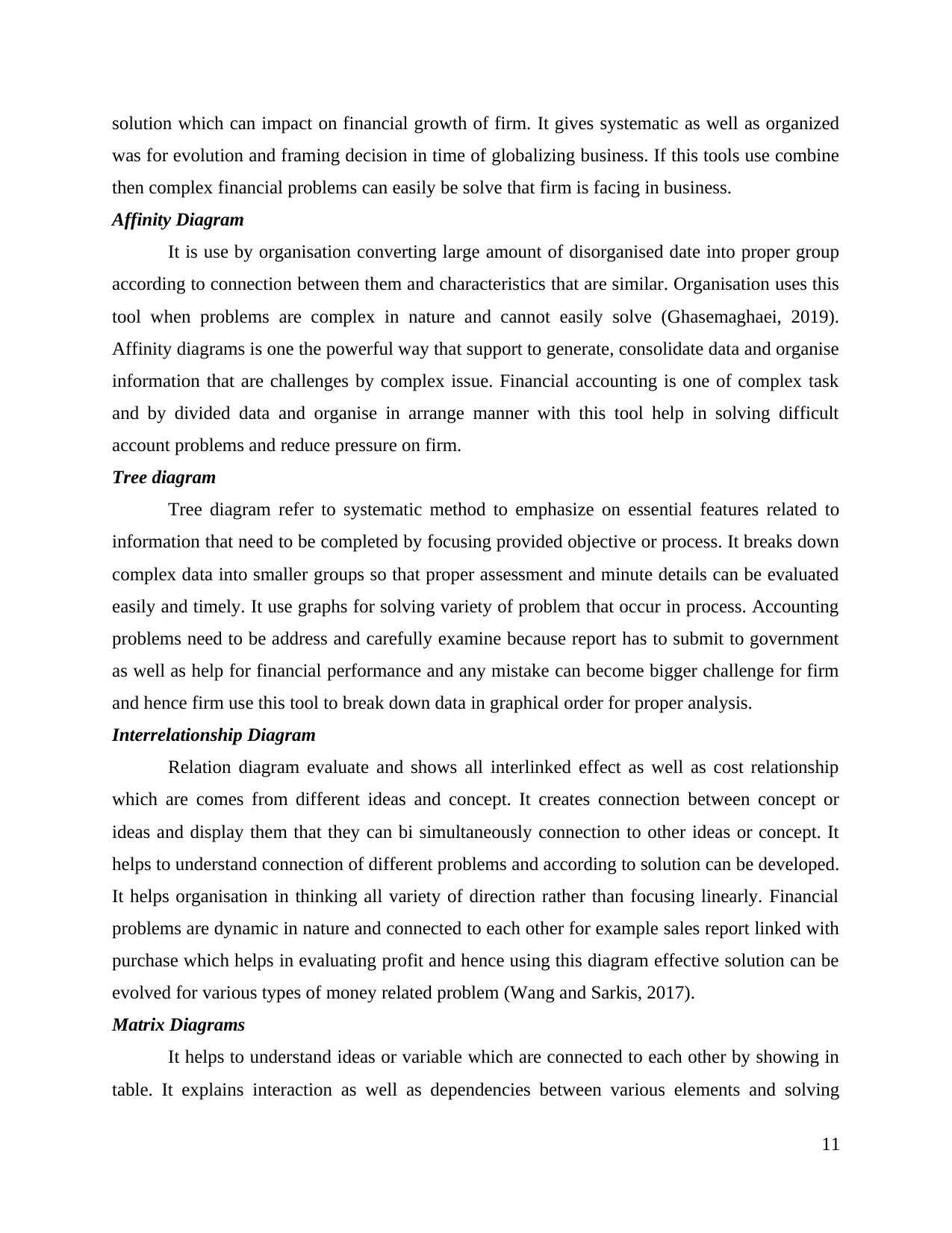
solution which can impact on financial growth of firm. It gives systematic as well as organized
was for evolution and framing decision in time of globalizing business. If this tools use combine
then complex financial problems can easily be solve that firm is facing in business.
Affinity Diagram
It is use by organisation converting large amount of disorganised date into proper group
according to connection between them and characteristics that are similar. Organisation uses this
tool when problems are complex in nature and cannot easily solve (Ghasemaghaei, 2019).
Affinity diagrams is one the powerful way that support to generate, consolidate data and organise
information that are challenges by complex issue. Financial accounting is one of complex task
and by divided data and organise in arrange manner with this tool help in solving difficult
account problems and reduce pressure on firm.
Tree diagram
Tree diagram refer to systematic method to emphasize on essential features related to
information that need to be completed by focusing provided objective or process. It breaks down
complex data into smaller groups so that proper assessment and minute details can be evaluated
easily and timely. It use graphs for solving variety of problem that occur in process. Accounting
problems need to be address and carefully examine because report has to submit to government
as well as help for financial performance and any mistake can become bigger challenge for firm
and hence firm use this tool to break down data in graphical order for proper analysis.
Interrelationship Diagram
Relation diagram evaluate and shows all interlinked effect as well as cost relationship
which are comes from different ideas and concept. It creates connection between concept or
ideas and display them that they can bi simultaneously connection to other ideas or concept. It
helps to understand connection of different problems and according to solution can be developed.
It helps organisation in thinking all variety of direction rather than focusing linearly. Financial
problems are dynamic in nature and connected to each other for example sales report linked with
purchase which helps in evaluating profit and hence using this diagram effective solution can be
evolved for various types of money related problem (Wang and Sarkis, 2017).
Matrix Diagrams
It helps to understand ideas or variable which are connected to each other by showing in
table. It explains interaction as well as dependencies between various elements and solving
11
was for evolution and framing decision in time of globalizing business. If this tools use combine
then complex financial problems can easily be solve that firm is facing in business.
Affinity Diagram
It is use by organisation converting large amount of disorganised date into proper group
according to connection between them and characteristics that are similar. Organisation uses this
tool when problems are complex in nature and cannot easily solve (Ghasemaghaei, 2019).
Affinity diagrams is one the powerful way that support to generate, consolidate data and organise
information that are challenges by complex issue. Financial accounting is one of complex task
and by divided data and organise in arrange manner with this tool help in solving difficult
account problems and reduce pressure on firm.
Tree diagram
Tree diagram refer to systematic method to emphasize on essential features related to
information that need to be completed by focusing provided objective or process. It breaks down
complex data into smaller groups so that proper assessment and minute details can be evaluated
easily and timely. It use graphs for solving variety of problem that occur in process. Accounting
problems need to be address and carefully examine because report has to submit to government
as well as help for financial performance and any mistake can become bigger challenge for firm
and hence firm use this tool to break down data in graphical order for proper analysis.
Interrelationship Diagram
Relation diagram evaluate and shows all interlinked effect as well as cost relationship
which are comes from different ideas and concept. It creates connection between concept or
ideas and display them that they can bi simultaneously connection to other ideas or concept. It
helps to understand connection of different problems and according to solution can be developed.
It helps organisation in thinking all variety of direction rather than focusing linearly. Financial
problems are dynamic in nature and connected to each other for example sales report linked with
purchase which helps in evaluating profit and hence using this diagram effective solution can be
evolved for various types of money related problem (Wang and Sarkis, 2017).
Matrix Diagrams
It helps to understand ideas or variable which are connected to each other by showing in
table. It explains interaction as well as dependencies between various elements and solving
11
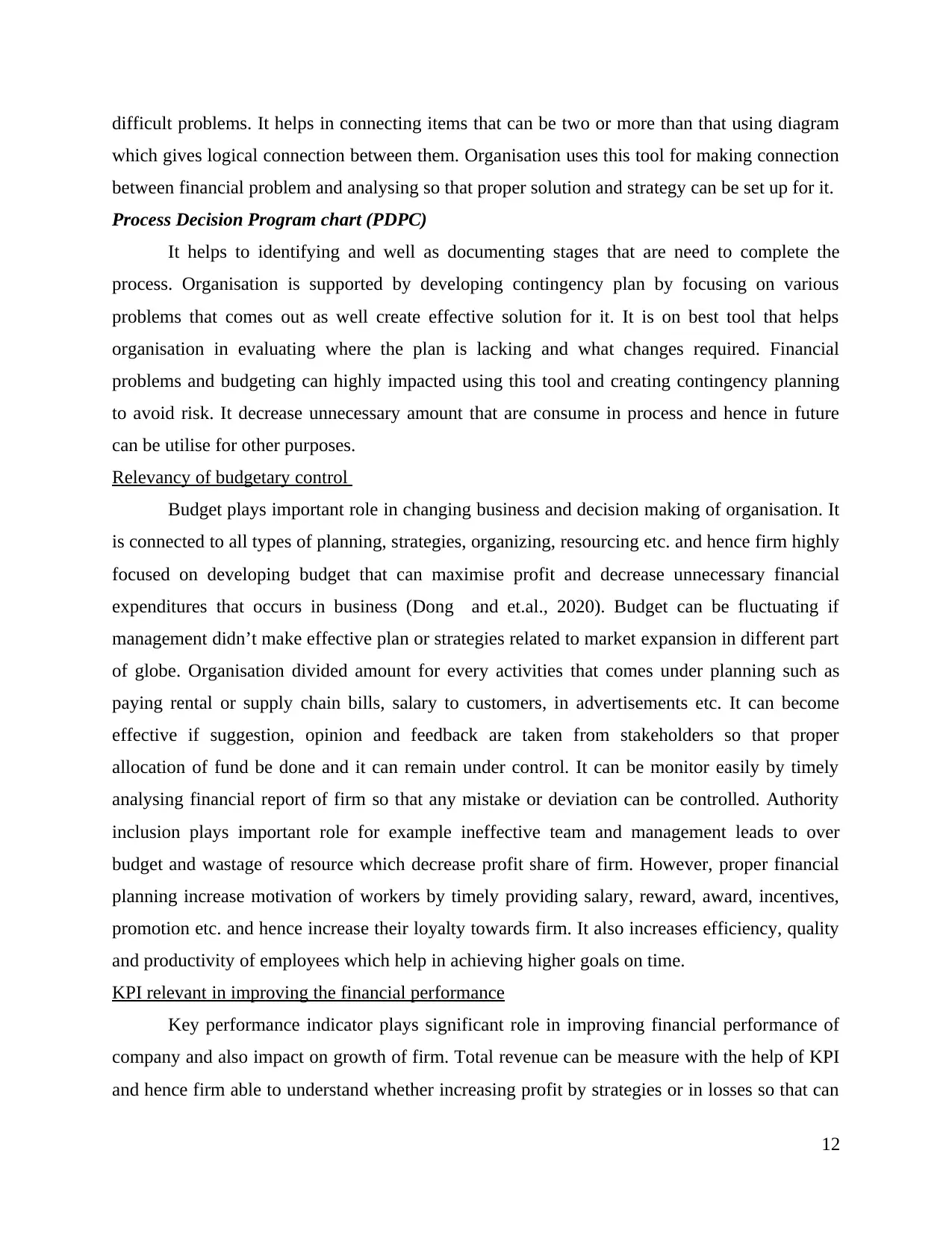
difficult problems. It helps in connecting items that can be two or more than that using diagram
which gives logical connection between them. Organisation uses this tool for making connection
between financial problem and analysing so that proper solution and strategy can be set up for it.
Process Decision Program chart (PDPC)
It helps to identifying and well as documenting stages that are need to complete the
process. Organisation is supported by developing contingency plan by focusing on various
problems that comes out as well create effective solution for it. It is on best tool that helps
organisation in evaluating where the plan is lacking and what changes required. Financial
problems and budgeting can highly impacted using this tool and creating contingency planning
to avoid risk. It decrease unnecessary amount that are consume in process and hence in future
can be utilise for other purposes.
Relevancy of budgetary control
Budget plays important role in changing business and decision making of organisation. It
is connected to all types of planning, strategies, organizing, resourcing etc. and hence firm highly
focused on developing budget that can maximise profit and decrease unnecessary financial
expenditures that occurs in business (Dong and et.al., 2020). Budget can be fluctuating if
management didn’t make effective plan or strategies related to market expansion in different part
of globe. Organisation divided amount for every activities that comes under planning such as
paying rental or supply chain bills, salary to customers, in advertisements etc. It can become
effective if suggestion, opinion and feedback are taken from stakeholders so that proper
allocation of fund be done and it can remain under control. It can be monitor easily by timely
analysing financial report of firm so that any mistake or deviation can be controlled. Authority
inclusion plays important role for example ineffective team and management leads to over
budget and wastage of resource which decrease profit share of firm. However, proper financial
planning increase motivation of workers by timely providing salary, reward, award, incentives,
promotion etc. and hence increase their loyalty towards firm. It also increases efficiency, quality
and productivity of employees which help in achieving higher goals on time.
KPI relevant in improving the financial performance
Key performance indicator plays significant role in improving financial performance of
company and also impact on growth of firm. Total revenue can be measure with the help of KPI
and hence firm able to understand whether increasing profit by strategies or in losses so that can
12
which gives logical connection between them. Organisation uses this tool for making connection
between financial problem and analysing so that proper solution and strategy can be set up for it.
Process Decision Program chart (PDPC)
It helps to identifying and well as documenting stages that are need to complete the
process. Organisation is supported by developing contingency plan by focusing on various
problems that comes out as well create effective solution for it. It is on best tool that helps
organisation in evaluating where the plan is lacking and what changes required. Financial
problems and budgeting can highly impacted using this tool and creating contingency planning
to avoid risk. It decrease unnecessary amount that are consume in process and hence in future
can be utilise for other purposes.
Relevancy of budgetary control
Budget plays important role in changing business and decision making of organisation. It
is connected to all types of planning, strategies, organizing, resourcing etc. and hence firm highly
focused on developing budget that can maximise profit and decrease unnecessary financial
expenditures that occurs in business (Dong and et.al., 2020). Budget can be fluctuating if
management didn’t make effective plan or strategies related to market expansion in different part
of globe. Organisation divided amount for every activities that comes under planning such as
paying rental or supply chain bills, salary to customers, in advertisements etc. It can become
effective if suggestion, opinion and feedback are taken from stakeholders so that proper
allocation of fund be done and it can remain under control. It can be monitor easily by timely
analysing financial report of firm so that any mistake or deviation can be controlled. Authority
inclusion plays important role for example ineffective team and management leads to over
budget and wastage of resource which decrease profit share of firm. However, proper financial
planning increase motivation of workers by timely providing salary, reward, award, incentives,
promotion etc. and hence increase their loyalty towards firm. It also increases efficiency, quality
and productivity of employees which help in achieving higher goals on time.
KPI relevant in improving the financial performance
Key performance indicator plays significant role in improving financial performance of
company and also impact on growth of firm. Total revenue can be measure with the help of KPI
and hence firm able to understand whether increasing profit by strategies or in losses so that can
12
⊘ This is a preview!⊘
Do you want full access?
Subscribe today to unlock all pages.

Trusted by 1+ million students worldwide
1 out of 16
Related Documents
Your All-in-One AI-Powered Toolkit for Academic Success.
+13062052269
info@desklib.com
Available 24*7 on WhatsApp / Email
![[object Object]](/_next/static/media/star-bottom.7253800d.svg)
Unlock your academic potential
Copyright © 2020–2025 A2Z Services. All Rights Reserved. Developed and managed by ZUCOL.





